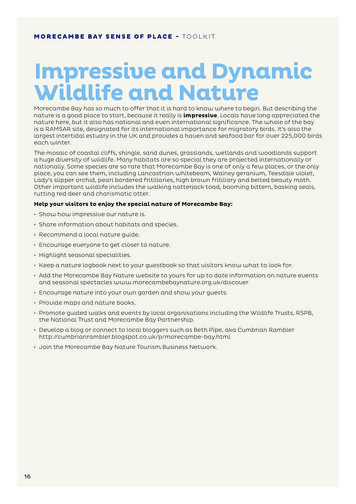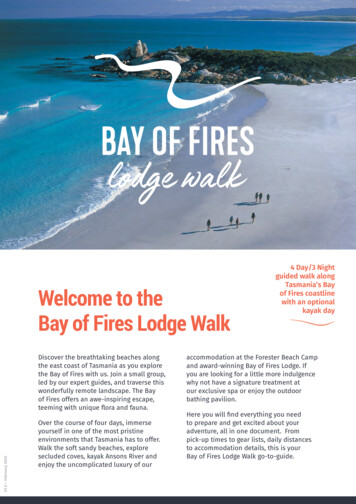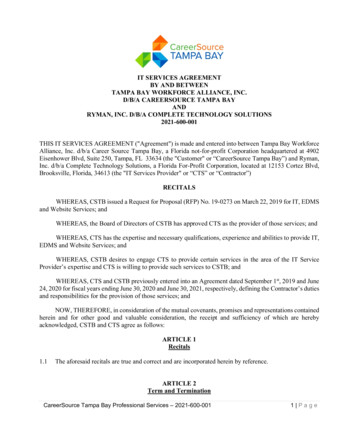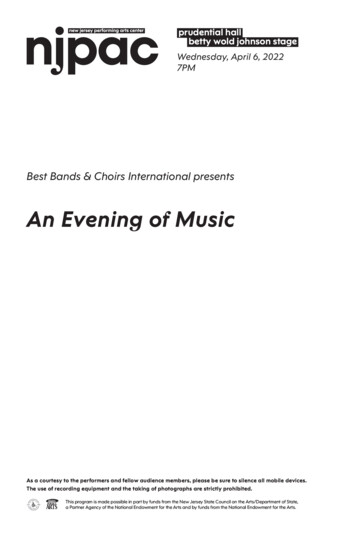
Transcription
M O R E C A M B E B AY S E N S E O F P L A C E - TO O L K I TImpressive and DynamicWildlife and NatureMorecambe Bay has so much to offer that it is hard to know where to begin. But describing thenature is a good place to start, because it really is impressive. Locals have long appreciated thenature here, but it also has national and even international significance. The whole of the bayis a RAMSAR site, designated for its international importance for migratory birds. It’s also thelargest intertidal estuary in the UK and provides a haven and seafood bar for over 225,000 birdseach winter.The mosaic of coastal cliffs, shingle, sand dunes, grasslands, wetlands and woodlands supporta huge diversity of wildlife. Many habitats are so special they are projected internationally ornationally. Some species are so rare that Morecambe Bay is one of only a few places, or the onlyplace, you can see them, including Lancastrian whitebeam, Walney geranium, Teesdale violet,Lady’s slipper orchid, pearl bordered fritillaries, high brown fritillary and belted beauty moth.Other important wildlife includes the walking natterjack toad, booming bittern, basking seals,rutting red deer and charismatic otter.Help your visitors to enjoy the special nature of Morecambe Bay: Show how impressive our nature is. Share information about habitats and species. Recommend a local nature guide. Encourage everyone to get closer to nature. Highlight seasonal specialities. Keep a nature logbook next to your guestbook so that visitors know what to look for. Add the Morecambe Bay Nature website to yours for up to date information on nature eventsand seasonal spectacles www.morecambebaynature.org.uk/discover Encourage nature into your own garden and show your guests. Provide maps and nature books. Promote guided walks and events by local organisations including the Wildlife Trusts, RSPB,the National Trust and Morecambe Bay Partnership. Develop a blog or connect to local bloggers such as Beth Pipe, aka Cumbrian ecambe-bay.html Join the Morecambe Bay Nature Tourism Business Network.16
Describing our Impressive WildlifeIt can be hard to describe why nature is so special with words alone - and we all know that apicture paints a thousand words. Use the gallery of photos on www.morecambebaynature.org.uk or snap your own to inspire your visitors. Why not ask your visitors to share their naturephotos with you on twitter and facebook?Nature appeals to all the senses, and the sounds can be as impressive as the sights. Listen torecordings on the RSPB website to give visitors a feel for the area’s evocative sounds.When we asked people whatthenature is like here they talkedabout the “impressive” nationaland international importanceofMorecambe Bay for both habitats andspecies. They described it piringbreathtakingmovingraises hairs on armbestgives megoosebumpsspecialFA S C I N AT I NG FACTSstcts to show ju3 fascinating faply istoalereesrethtuseUbe Bay naamecorMvesihow impreshas around 30ambe Bay areaecorMeThlife is so1.where the wildtionallynature reserves,lye regional naareythatthlspeciaand manylly protected,them areor internationaosplaces. M t ofchriretunaemord explore.free to visit anest intertidalBay is the largt2. Morecambemost importanain and is theitBrinyarl.tueserfowabirds and watestuary for see of the mostBay area is onbeeamecorMtry and Arnsid3. Theeas in the counarealrsurveatdiNobidingArea of Outstanand Silverdalethat overretunainper richecies canBeauty is so suspting planerwflosn’aiit2/3 of Brbe found there.unrivalledMorecambe Bay’s Big FiveWe might not have lions, zebras, or giraffes but Morecambe Bay is a great place for a naturesafari. Look out for our Big Five, while you explore the Bay:Grey Seal Ben AndrewrewOtter Ben AndRed Deer Ben Andrewllary D MorrisPearl Bordered FritimagesOystercatcher Andy Hay rspb-i17
M O R E C A M B E B AY S E N S E O F P L A C E - TO O L K I TNature Rich PlacesThe special nature of Morecambe Bay comes down to the many habitats you can find in sucha small area, providing homes and food for so many different species. The wildlife is so specialthat many areas are nationally or internationally protected, with many others having countywide protection.Here are some of the different habitats and species that live here, and some really good placesto explore – all have public access and some have information on site. Check out the mapure.org.showing many of these sites on www.morecambebaynature.org.uk/mapShores and sands Sand dunes at Sandscale Haws National Nature Reserveand North Walney National Nature Reserve, both nearBarrow, are home to the rare natterjack toad and rareplant species such as sea holly and sea lavender. Shingle beaches at South Walney nature reserve withgreat views to Piel and Foulney Islands. This is the onlyplace in Cumbria and Lancashire to see grey seals haulout onto the beach.J Wain Humphrey Head nature reserve is a lovely limestoneheadland near Flookburgh and one of the places to findendemic lancastrian whitebeam. This is only found around Morecambe Bay andnowhere else in the world. Beaches at Roa Island and Sandscale Haws NationalNature Reserve, North Walney National NatureReserve, South Walney nature reserve, Half Moon Bay(Heysham) or Rossall Point are great places for tidepooling and beachcombing.Estuaries and rivers Favourite places to watch birds are along the Duddon,Leven, Kent, Keer, Lune and Wyre Estuaries, aroundHumphrey Head, Grange, Arnside and MorecambePromenades, Hest Bank, Heysham Head, Glasson Docks,Cockersands Abbey, Pilling Lane Ends, Wyre EstuaryCountry Park and Rossall Point.FA S C I N AT I Narshflats and saltmThe sand .muddanllynaioatinternin the Bay arerected and covenationally protof Manchester.an area the sizes,inmarleigh MosThey include: WnsideArs,osLeighton M,agCrntoarWMoss,row, MeathopKnott, Whitbarandd, Walney IslandHumphrey Heas.Sandscale Haw Watch birds feed in the rich mud as the tide turns or seee.their numbers swell as they gather in roosts at high tide.The best time to see them is 2 hours before or after hightide as they are pushed closer to land. The site of over10,000 knot flying together over Middleton Sands is asight to remember. Estuary sites are perfect for first time bird watchers with wideopen spaces and scenic walks to enjoy and you’re usually nottoo far from a café with a view. Lapwing, curlew and oystercatcher are often seen in farmfields nearby the rivers and estuaries. Many farmers take pridein giving nature a home in places such as Rusland Valley, LythValley, Arnside & Silverdale AONB, Lancaster, Sunderland Pointand Cockerham. The large wetlands in Arnside & Silverdale AONB, andespecially Leighton Moss nature reserve provide a haven forall sorts of wildfowl, waders, otters and eels, including the elusive bittern.18G FACTS
Woodlands Woodlands like Roudsea Woods National NatureReserve, near Ulverston provide food and shelter fordbirds and mammals, including the rare red squirrels anddormice. The Lancastrian whitebeam is only found in a fewplaces, such as Humphrey Head nature reserve andGrubbins Wood, near Arnside. Arnside & Silverdale AONB still has numerous traditionalalorchards and a celebratory Apple Day is held in earlyOctober every other year.AONB Merlewood and Egglerslack woods, atGrange over Sands, and woodlands around Whitbarrow National Nature Reserve arefantastic for springtime blue bells and wild garlic, with Brigsteer Woods and the woodlands ofArnside & Silverdale AONB having all these and thousands of wild daffodils too. Coppicing isalso common in these woods. The woods around Hampsfield are a juniper temperate rainforest. The emerald green juniperbushes are hidden in the scrub.Limestone grasslands Wildlife thrives on limestone rocks. Around the northern edge ofMorecambe Bay you can find limestone grasslands, pavementsand cliffs. In Spring, these species-rich grasslands are coveredin colourful and sweet-smelling herbs and wildflowers such asthyme, rock rose and orchids. Great places for limestone grassland include Brown Robin naturereserve, Helsington Barrow, around Sizergh Estate, ArnsideKnott, Warton Crag nature reserve and elsewhere in Arnside &Silverdale AONB, Whitbarrow National Nature Reserve and ScoutScar. Throughout spring and summer you’ll find a multitude ofbutterflies here, and maybe some birds of prey overhead. At limestone coastal areas like Jack Scout, Humphrey Head naturereserve, and St Patricks Chapel you’ll find caves and cliffs andgreat views across the bay and out to sea as well as flower andorchid rich grasslands.dlimestone pavement Natural EnglanDavid Wakeley Famous limestone pavement sites can be found at Urswick, Whitbarrow nature reserve andHampsfell, with the best example at Gait Barrows National Nature Reserve. These fascinating‘moonscapes’ are great to explore in winter and make a great backdrop for photographs.Bogs and mosses Bogs and mosses are fascinating places, packed withweird and wonderful plants and a good place to spotdeer. Explore 3 National Nature Reserves - Duddon Mosses,Roudsea Woods and Mosses and Rusland Valley Mosses,and 5 other nature reserves including Meathop Moss,Foulshaw Moss, Nichols Moss, Winmarleigh Moss andHeysham Moss. Bog asphodel turns a brilliant orange colour inSeptember. David Morris In spring and summer these provide a haven forbutterflies and dragonflies and the rare bog bush cricket.19
M O R E C A M B E B AY S E N S E O F P L A C E - TO O L K I TSpectacular SpeciesThe rich mosaic of habitats support a huge diversity of wildlife, and Morecambe Bay is a havenfor birds and butterflies in particular. Great facts to share with your visitors include: Morecambe Bay is home to a range of nationally significant endemic and rare species. Morecambe Bay has one of the biggest over-wintering and passage populations of wadingbirds and wildfowl in Britain. It forms a crucial part of a network of estuaries providing ahaven for migrating birds. They can feed and roost before continuing on with their longjourneys. The Morecambe Bay area is the only place in the world where the Lancastrian whitebeamoccurs. South Walney nature reserve hosts the principal grey seal haul-out site for Lancashire andCumbria. Natterjack toad ponds can be found at sites around Barrow and Walney Island. Leighton Moss nature reserve is home to bearded tits, marsh harriers and rare avocets. Arnside & Silverdale AONB and the limestone hills around the Bay are the most importantplaces for butterflies in the north of England. They are the national stronghold for high brownfritillary and the duke of burgundy – two of Britain’s most threatened butterflies.For a detailed list of wildlife and the best places and times to share with your visitors connectto ris David Mo David Morris Eleanor Bentall rspb20images
Nature for EveryoneSome nature in Morecambe Bay is accessible and predictable, while some is hidden awayand rare. Know your audience, from novice to experienced nature watchers, and describeappropriate nature experiences.New Nature WatchersTell new nature watchers about the nature that is close up and on your doorstep. There areplenty of impressive sites and species that are easy to find and will capture their imagination.Pack in a week of wildlife watching with our pick of the best 10 sites for beginners:1.Listen out for the call of natterjack toads with National Trust rangers at Sandscale HawsNational Nature Reserve.2. Watch the seals playing in the surf around Lighthouse Bay and on the beaches at the end ofSouth Walney nature reserve.3. Walk amongst the butterflies and flowers that are abundant in Summer at WhitbarrowNational Nature Reserve.4. Follow easy walks around Sizergh Castle estate and spot hawfinches in spring from thevisitor centre outdoor deck.5. Seek out rare orchids along the nature trail at Gait Barrows National Nature Reserve.6. See a live showcase of the thousands of oystercatcher, knot and curlew that visitMorecambe Bay at Arnside, Morecambe, and Grange Promenades a couple of hours before orafter high tide.7.Follow lapwing, golden plover, knot and redshank on a walk or cycle ride along the LuneEstuary to Glasson Dock.8. Look for the flash of colour as the red deer rut among the reed beds in autumn at LeightonMoss nature reserve and in nearby fields. The males will go head to head for the right tomate with the females, bellowing across the reserve at one another and locking antlers inbattle.9. In autumn, watch flocks of up to 100,000 starlings as they sweep in before sunset to rooston the Leighton Moss nature reserve.10. Learn about the coast and look out for redshank, dunlin and turnstone on the beach fromRossall Point Observatory.Leighton Moss nature reserveBen HallSouth Walney nature reserve Susannah Bleakley21
M O R E C A M B E B AY S E N S E O F P L A C E - TO O L K I TKeen Wildlife LoversIf your visitors are keen nature lovers, you’ll find some rare and unusual species. These are ourtop 10 sites for truly unique viewing:1.Stick to the paths and pull our your binoculars to see the arctic and little tern nesting atFoulney Isand nature reserve.2. Head to Brown Robin nature reserve to seek out waxcap fungi.3. Spot the difference between the limestone and sandstone forests at Whitbarrow NationalNature Reserve.4. Tick the endemic Walney geranium off your list at North Walney National Nature Reserve.5. Brush up on your orchid ID at Hodbarrow nature reserve, Gait Barrows National NatureReserve, Arnside Knott and Latterbarrow nature reserve.6. Look out for marsh harriers hunting prey above the reeds at Leighton Moss nature reserve.7.Head to Foulshaw Moss nature reserve, the only place in Morecambe Bay to spot whitefaced darter dragonfly and nesting osprey.8. See if you can find the rare duke of burgundy on scrubby grassland and sunny woodlandclearings at High Dam.9. Warton Crag nature reserve is the best place to find the rare and threatened high brownfritillary, spot the caterpillars on the violets that grow amongst the bracken.10. Walk along the causeway at Leighton Moss nature reserve in autumn to watch the beardedtit filling up on grit from the specially placed grit trays.For more detailed information on these places, visit the websites of the charities and bodiesthat care for them: Arnside & Silverdale AONB Cumbria Wildlife Trust Forestry CommissionCASE STUDY National TrustRSPB Leighton Moss Natural England Lancashire Wildlife Trust RSPB Wyre Borough Council Ben Hall22We expect the RSPBto be good at promoting nature,but they go aboveand beyond to make wildlifewatching accessible to everyone at RSPB LeightonMoss nature reserve . Visitors are invited to posttheir recent sightings in the visitor centre, so thatothers know whatto look out for. Clickon theirwebpage and the first thing you will see is “Topthings to do in winter” (or whichever season we arein.). By highlightinghow wildlife changes from dayto day and seasonto season, they shownew wildlifewatchers what tolook for, and enticeexperiencednature lovers to come back again."Annabel Rushton, marketing managerfor the reservesays, “There is something new and exciting to seeevery season. Visitors don’t necessarilyknow this,so it is our job to make sure people havethe bestpossible experience when they are here, and let themknow about the amazing opportunitiesthere are toget close to natureat any time of year, to encouragethem to come back. From booming bitterns inspring, regal red deer in summer, swirling starlings inautumn and dazzling ducks in winter, there is a lot tobe discovered.”
Seasonal Specialitiesfrom season toThe nature in Morecambe Bay is so dynamic, and changese as:naturseason, or even from day to day. You could describe rentseasonalalways something newGiGiveyour visitors even more reasons to stay longer and come back again by highlighting ourdynamic wildlife offer. Here are some specialities for each season:SPRING green hairstreak butterfly and emperor moth orchids and thousands of spring flowers like wild garlic and daffodils avocets, hawfinch, marsh tit and peregrine natterjack toads the first migrants of the year - arctic, little and sandwich terns and pink footed geese (theyappear in autumn too)SUMMER young red deer lots of butterflies like pearl bordered fritillary, small pearl bordered fritillary, high brownfritillary, and northern brown argus rare plants such as dark red helleborine and sundew dragonflies and damselflies like brown hawker dragonfly , black darter dragonfly and largered damselfly the metallic green tiger beetleAUTUMN starling murmurations – an amazing nature spectacle thousands of pink footed geese grazing on saltmarsh (dawn and dusk are the best times tosee them) knot (around high spring tides is best) bearded tits at Leighton Moss nature reserve (on a fine morning is best) waxcap fungi on woodland floorsWINTER grey seals (you can see these all year round but winter high tide is best) as their name suggests, november and december moths keep your eyes peeled and you may spot a bittern walking across frozen reedbedsFor the most up to date nature activities and seasonal spectacles visit Morecambe Bay Naturewebsite23
endemic lancastrian whitebeam. This is only found around Morecambe Bay and nowhere else in the world. Beaches at Roa Island and Sandscale Haws National Nature Reserve, North Walney National Nature Reserve, South Walney nature reserve, Half Moon Bay (Heysham) or Rossall Point are great places for tide pooling and beachcombing. Estuaries and .










